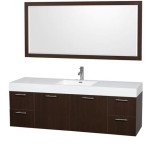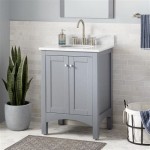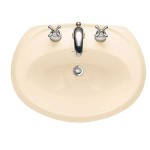Classic Small Bathroom Design Ideas
Designing a small bathroom presents a unique set of challenges. Maximizing space, ensuring functionality, and achieving a desired aesthetic requires careful planning and creative solutions. A classic design approach, characterized by its timeless appeal and emphasis on practicality, can be particularly effective in transforming a cramped bathroom into a serene and inviting space.
Classic design transcends fleeting trends, focusing instead on enduring elements such as clean lines, neutral color palettes, and high-quality materials. This approach does not necessarily denote ornate or extravagant features, but rather prioritizes simplicity, elegance, and a sense of enduring style. In the context of a small bathroom, this translates to designs that are both visually appealing and highly efficient.
A successful classic small bathroom design requires meticulous attention to detail. Every element, from the choice of fixtures to the selection of accessories, contributes to the overall harmony and functionality of the space. By carefully considering the layout, color scheme, and material choices, it is possible to create a bathroom that feels larger and more luxurious than its actual dimensions suggest.
Optimizing Space and Layout
Space optimization is paramount in small bathroom design. Every square inch must be utilized effectively to ensure a comfortable and functional environment. Careful consideration of the layout is the first step in maximizing space and creating a sense of openness.
One effective strategy is to replace a traditional bathtub with a shower enclosure. Showers generally occupy less floor space and can be customized to fit specific dimensions. Walk-in showers, often featuring glass panels, can create a more open and airy feel, visually expanding the bathroom.
Wall-mounted sinks and toilets are another excellent option for saving space. By freeing up floor space, these fixtures create the illusion of a larger room and facilitate easier cleaning. The space beneath a wall-mounted sink can be utilized for storage, further enhancing functionality.
Corner sinks are specially advantageous for small bathrooms. These sinks tuck neatly into a corner, freeing up floor space along the walls. This can be particularly useful in narrow bathrooms where every inch counts. Corner storage units can also be utilized to complement the corner sink.
Vertical storage is crucial in small bathrooms. Tall, narrow cabinets or shelving units can provide ample storage without occupying valuable floor space. These units can be used to store toiletries, towels, and other bathroom essentials, keeping the countertop and floor clutter-free.
Mirrored cabinets are a practical and stylish storage solution. These cabinets provide concealed storage while also serving as a mirror, which can visually enlarge the room. The mirrored surface reflects light, making the bathroom appear brighter and more spacious.
The door swing can also impact space utilization. If space is extremely limited, consider replacing a traditional swing door with a pocket door or a sliding door. Pocket doors slide into the wall, eliminating the need for swing space and allowing for more efficient use of the available area. Sliding doors offer a similar space-saving benefit and can add a modern touch to a classic design.
Selecting a Classic Color Palette and Materials
The color palette plays a crucial role in establishing the overall mood and aesthetic of a bathroom. Classic designs typically favor neutral colors, which create a sense of calm and sophistication. These colors also tend to make small spaces feel larger and more open.
White is a timeless choice for bathroom walls and fixtures. It reflects light effectively, making the room feel brighter and more spacious. White also serves as a versatile backdrop for other colors and materials, allowing for flexibility in adding decorative accents.
Cream and beige are warm and inviting alternatives to white. These colors add a touch of sophistication while still maintaining a sense of neutrality. They pair well with natural materials such as wood and stone, creating a classic and elegant look.
Gray is another popular choice for classic bathroom designs. Light gray shades can create a sophisticated and contemporary feel, while darker grays can add depth and drama. Gray pairs well with both white and wood tones, offering a versatile palette for creating a balanced and harmonious space.
Accents of color can be added through accessories such as towels, rugs, and artwork. Soft blues, greens, or yellows can introduce a touch of personality and warmth to the neutral palette without overwhelming the space. These accents should be carefully chosen to complement the overall design scheme and maintain a sense of balance.
Material selection is equally important in creating a classic bathroom design. High-quality materials that are durable and visually appealing will stand the test of time and contribute to the overall sense of luxury. Classic materials such as marble, granite, and porcelain are excellent choices for bathroom surfaces.
Marble is a timeless and elegant material that adds a touch of luxury to any bathroom. It is available in a wide range of colors and patterns, allowing for customization and personalization. Marble can be used for countertops, flooring, and shower walls, creating a cohesive and sophisticated look.
Granite is another durable and aesthetically pleasing material that is well-suited for bathroom applications. It is resistant to water damage and staining, making it a practical choice for countertops and flooring. Granite is available in a variety of colors and textures, allowing for a wide range of design possibilities.
Porcelain tile is a versatile and affordable option for bathroom flooring and wall coverings. It is durable, water-resistant, and easy to clean, making it a practical choice for high-traffic areas. Porcelain tile is available in a wide range of styles and patterns, including options that mimic the look of natural stone.
Wood accents can add warmth and character to a classic bathroom design. Wooden vanities, shelving units, or mirror frames can introduce a natural element to the space, creating a sense of balance and harmony. The type of wood should be carefully chosen to complement the overall color palette and aesthetic. Light-colored woods such as maple or birch can create a bright and airy feel, while darker woods such as walnut or cherry can add a sense of richness and sophistication.
Incorporating Classic Fixtures and Accessories
The selection of fixtures and accessories is crucial in completing the classic bathroom design. These elements should be carefully chosen to complement the overall aesthetic and enhance the functionality of the space.
Classic fixtures are characterized by their timeless designs and high-quality craftsmanship. Traditional faucets, showerheads, and towel bars are often made from polished chrome or brushed nickel, which offer a clean and sophisticated look. These finishes are also durable and resistant to corrosion, making them well-suited for bathroom environments.
A pedestal sink is a classic fixture that adds a touch of elegance to any bathroom. It features a sleek and minimalist design that is both visually appealing and space-saving. Pedestal sinks are available in a variety of styles and sizes, making them suitable for small bathrooms with limited floor space.
A clawfoot tub is another classic fixture that can transform a bathroom into a luxurious retreat. These tubs feature ornate legs and a deep basin, providing a comfortable and relaxing bathing experience. Clawfoot tubs are available in a variety of materials, including cast iron and acrylic, allowing for customization and personalization.
Lighting plays a crucial role in setting the mood and enhancing the functionality of a bathroom. Classic lighting fixtures typically feature simple and elegant designs. Sconces, pendant lights, and recessed lighting can be used to create a layered lighting scheme that provides ample illumination while also adding visual interest.
Mirrors are essential elements in any bathroom, serving both a practical and decorative purpose. A large, frameless mirror can visually enlarge the room and reflect light, making the space feel brighter and more open. Decorative mirrors with ornate frames can add a touch of elegance and sophistication to the classic design.
Accessories such as towels, rugs, and soap dispensers should be carefully chosen to complement the overall color palette and aesthetic. High-quality towels in neutral colors such as white, beige, or gray can add a touch of luxury and comfort. A plush rug can provide warmth and softness underfoot, while also adding a pop of color or pattern to the space.
Artwork and plants can add personality and character to a classic bathroom design. Framed prints or paintings can introduce a touch of visual interest, while potted plants can bring a sense of life and freshness to the space. These elements should be carefully chosen to complement the overall design scheme and create a balanced and harmonious environment.
By carefully considering these elements, it is possible to create a classic small bathroom design that is both functional and aesthetically pleasing. The key is to prioritize space optimization, select a timeless color palette and materials, and incorporate classic fixtures and accessories that enhance the overall harmony of the space.
:strip_icc()/102748014-d55ecdc38d874814b6afce60d35e05c5.jpg?strip=all)
Traditional Bathroom Decor Ideas

5 Nature Inspired Traditional Bathrooms Burlington

Small Bathroom Ideas To Amp Up Designs 20

60 Small Bathroom Ideas Make It Look Bigger The Nordroom

20 Traditional Bathroom Designs Timeless Ideas

60 Small Bathroom Ideas Make It Look Bigger The Nordroom
.jpg?strip=all)
15 Beautiful Small Bathrooms My Mommy Style

54 Small Bathroom Ideas Best Tiny Designs
:strip_icc()/102157515-939d4e1461444f6b8a8ac2a83d0a71f8.jpg?strip=all)
19 Vintage Bathroom Ideas For Retro Style

How To Create A Classic Bathroom Design That Lasts The Decorologist
Related Posts







